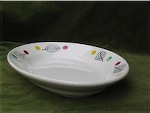|
Amongst the many faience manufacturers in the 19th century, the reputation of the Gien manufacturers is equal to those of the factories of Creil-Monterau, Longwy, Sarreguemines or Bordeaux. The faience manufacturers in Gien fully grasped the art of imitation and produced copies of old objects at a reasonable price. Moreover, employing talented ornamental painters, unique pieces were created. They applied both new decorations and decorations inspired by those from previous centuries, inspired by other European manufacturers or from those originating from the Far East. |
|
|
In 1821 Thomas Edme Hulm, also called "Hall", wound up his factory in Montereau which had been run by his family since 1774 and bought the ground and buildings of the old convent of Minimes to start a new factory where he started producing faience using the English method. At first he aimed at producing crockery, later he started producing dinner services, decorative pieces and dinner services embellished with family arms. The production of oil lamps was another typical speciality of Gien. |
Gien hors-d'oeuvre dish. |
|
The faience manufacturers of Gien have further developed the technique of emaux cloisonné, which originates from Longwy, in 1870. The pinnacle of the faience production of Gien was between 1855 and 1900 and many prizes were granted at the international exhibitions in 1855, 1867, 1878, 1889 and 1900. Decorations listed below are typical for Gien faience:
|
|




